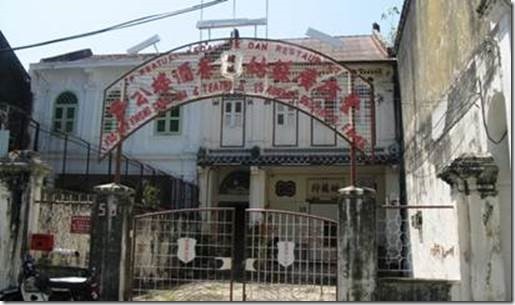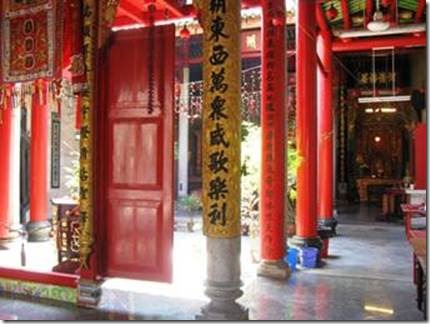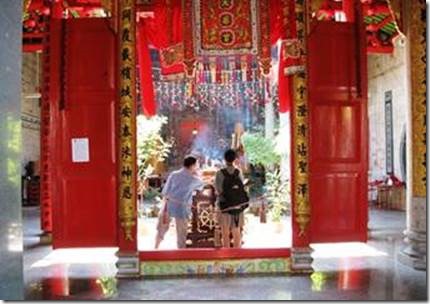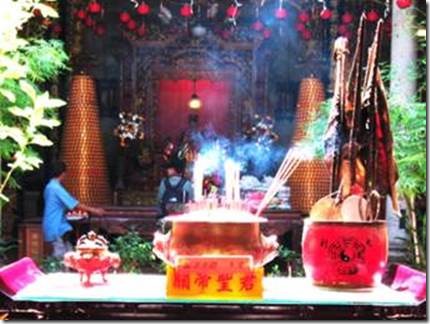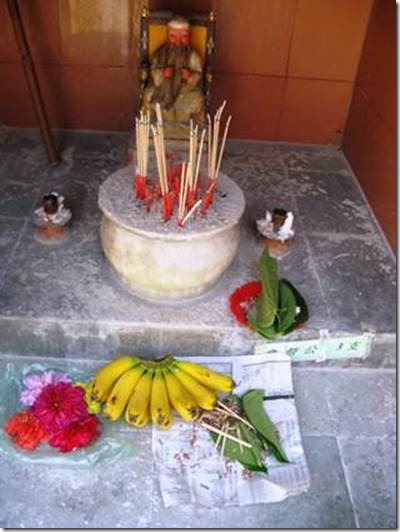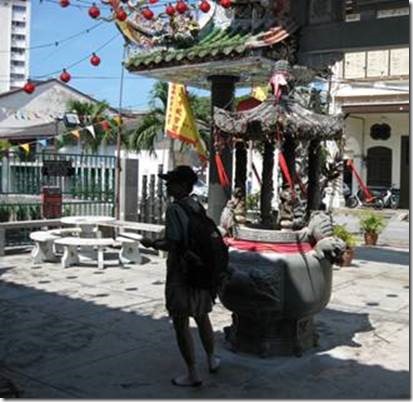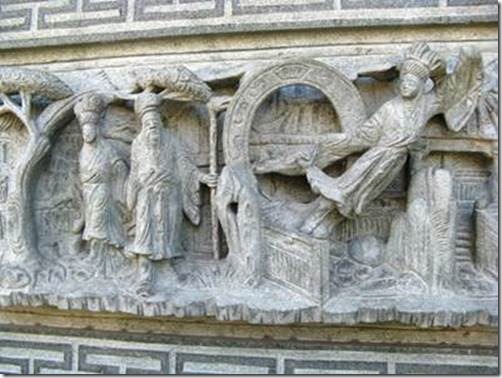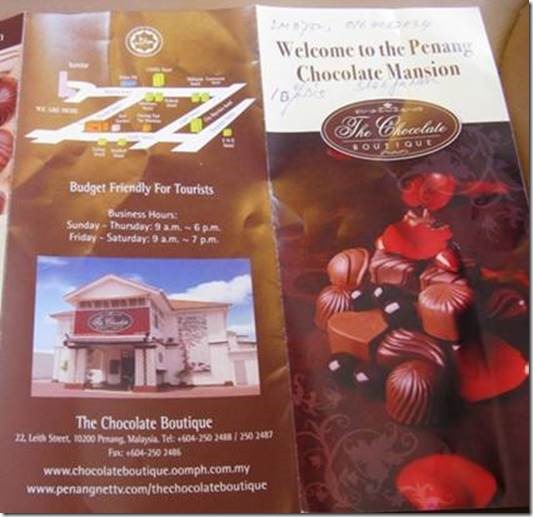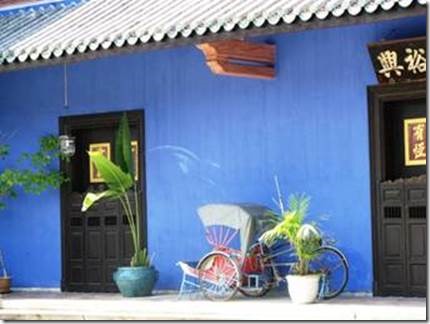Hi Everyone,
Randal and I went off to a Rally event yesterday and had our first glimse of mainland Langkawi. The last event is the final dinner tomorrow evening. In the morning we’ll take the free Rebak Marina high speed motor ferry to the mainland for the veggie man. He makes a stop near where we arrive. He comes once each week on Friday so we’ll load up.
Ru
The Penang Chocolate Mansion
One last bit of information about the tea shop, its web address: www.e-art2u.com. The web site explains the philosophy of the group of businessmen who bought and renovated the historic building and now want to support and promote local artists of Penang. And I realize now that the young man who served us tea is not the owner, Datuk Seri* Tan Khoon Hai, but does look quite a bit like him so might be related. *an honorary title awarded by the State. The official opening was in November of 2008 so it is an historic building with a new purpose.
We walked to the end of Muntri Street which is the home to many Chinese Associations and Guilds. My favorite bit of information concerns the Chinese amahs. “The association of Chan, Seng, Thong, Heong and Wooi surnames represent a joint association formed by a small group of Chinese with these surnames in Penang. A look at the pictures hanging on the wall (in the association building) reveals that the members are predominantly amahs. In the 1930s, these Cantonese women migrated in waves to Malaysia and Singapore to work for wealthy European and Chinese households. The “black-and-white” Cantonese amahs had impeccable reputations as live-in nannies, servants and cooks. Upright and frugal, they wore a uniform of white top and black pants, keeping their own moral cold, foreswearing marriage and family life to join the sisterhood. Careers as overseas amahs were an alternative to the peasant’s life in China and potential oppression by husbands and mothers-in-law. … “ Streets of George Town Penang The book continues talking about the amahs who have now reached old age and though some have returned to China, many remain in George Town in “shared quarters.” I think it’s really interesting how they chose their lives. Women in the silk industry did the same thing, becoming a sisterhood as well as co-workers. It definitely makes me want to know more about them and I will find out more when we return to Penang.
An example of a Chinese Association building on Muntri Street.
We did get to eat chocolate and I will tell you about it, but before the chocolate tasting came the incense burning. I needed to light more incense for the Red Sox since I had redirected my prior Sox incense wishes toward the solution of our fishing net mishap. Sometimes my priorities are straight. However, when I looked at my photos I couldn’t remember the name of the temple. I could sort of remember things by the order of the photos, but then I mixed up in my head what Elizabeth had told me about the different temples we had seen. So I dashed off a quick, “Help!” email to E and this is her charming reply. ….
I tried to find out about the George Town name at the Penang Heritage Centre
but after waiting for more than ten minutes when the employees didn’t
interrupt their conversations, I left, so I have no official ruling on
the name.
The Temple by the joss stick maker is the Goddess of Mercy Temple. It
has the incense and pigeons. The one where you lit the joss sticks is
the Hainan Temple on Muntri Street. It is also called the Thean Ho
Keong meaning “Temple of the Heavenly Queen”. Apparently it was
founded in 1866 and is dedicated to the goddess Mar Choo, patron saint
of seafarers. It was renovated in 1995. Part of its charm is the
natural lighting and that it is off the main tourist track. (I’ve
taken this from the black Historic George Town Trails booklet which is
the one with the black cover. There should be more information in the
Penang book).
Hope that helps.
Cheers from rust. LBD is now so well fed by the children that our
scraps are refused until she wants a late snack.
You can see why Elizabeth was such a great guide: I just wasn’t a very apt pupil.
The natural lighting.
The Streets book did add that a few more facts, the most interesting being that “Goats are slaughtered in offering to the goddess on her birthday.”
The man from the temple walked around with me since I really didn’t know exactly what to do.
I bought a pack of 15 incense sticks and then proceeded around the temple stopping at different spots to light the incense. It actually isn’t a complicated process once you have done it one or two times; and most temples have a similar procedure. I just do it so infrequently, though my real hesitation comes from feeling that I might be infringing on someone else’s religion for my non-religious reasons. However, one pays for the incense so I guess it goes for the upkeep of the temples and the temple workers are always gracious and helpful.
I think I’m at the third stop now.
Some of those sticks are mine.
I’m at the last stop to put in my last batch of incense.
I’m parading around in my socks: you always remove your shoes to enter a temple unless told otherwise as well as at many museums and even some shops.
There were stone carved reliefs were on the outside temple walls. We were told that the stone came from China though I’m not sure where the carving was done.
All of the photos of the temple that I’m in were taken by Elizabeth
Then we were off again. I don’t remember if we were aiming for the Chocolate Mansion or the “Blue House,” but the Mansion came first so we forced ourselves to go in.
This is the brochure: they were generous with the samples but didn’t allow photos.
We sampled away as our “guide” tempted us with a variety of the locally made chocolate. My favorite, believe it or not, was the chili chocolate. It had such a strong and unique flavor that you wouldn’t need much to be satisfied. Then we went to the coffee tasting room. My favorite was the mixture of tea and coffee. Oddly very good. But the prices weren’t tempting and anything we bought would have been a melted mess by the time we returned to the boats. And after all of the samples I felt pretty chocolated out for a while. Randal is satisfied with a cheapo Snickers bar and I can get by with a teaspoon full of Nutella. We’re such gourmands (if that’s the right word.) Full and no poorer for our treat, we left!
www.chocolateboutique.oomph.com.my and www.penangnettv.com/thechocolateboutique are the two web addresses listed on the back of the brochure.
This bit on the brochure struck me as funny. “Visit Malaysian Collection” “How do you know you’ve been in Malaysia? With those mouth-watering chocolates in the shape of Malaysian symbolic architecture now you can bring “Malaysia” home. “ Somehow that’s just a funny image to me, eating the places that you just visited. (During our visit to Langkawi yesterday, one of the Rally stops was a similar Chocolate shop with the same chocolate and same sample tastings. I still didn’t buy any. Earlier in the day Randal had bought some good ole Hershey Almond Kisses and that was more chocolate than we needed.)
One last stop for this email. Next along Leith St. was the “Blue House.”
Very blue.
The Cheong Fatt Tze Mansion rates two full pages in Streets. Unfortunately, when we got there, we learned that the next tour wouldn’t be for about an hour. Elizabeth had already been and my priority was to see the Jewish cemetery and some art, so I put it off for our next visit to Penang when Randal could see it too.
However, here is an interesting bit about Leith Street:
“At the turn of the century, Leith Street was “Hakka Millionaire’s Row “ Streets
“When the term “Hakka” first appeared in household registries during the Song Dynasty, it was used to indicate “guests” who had left their homelands to settle down in other parts of the country, in contrast to residents originally from the area. The Hakkas took to the road in five separate major migrations. The nickname “Jews of Asia” intimates these mass migrations and their pioneering spirit.” http://edu.ocac.gov.tw/lang/hakka/english/a/a.htm The Overseas Compatriot Affairs Commission of Taiwan provided this info. It’s amazing what I learn trying to explain bits of information to all of you.
I have one last story to tell, and anything else that pops up I forgot for my final (for now) George Town email. I hope to have lots more to share about Penang and George Town when we make return visits, possibly late this year and definitely next year.
Ru
DoraMac

